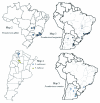Distributional patterns of Pseudacteon associated with the Solenopsis saevissima complex in South America
- PMID: 20050779
- PMCID: PMC3011915
- DOI: 10.1673/031.009.6001
Distributional patterns of Pseudacteon associated with the Solenopsis saevissima complex in South America
Abstract
Classical biological control efforts against imported fire ants have largely involved the use of Pseudacteon parasitoids. To facilitate further exploration for species and population biotypes a database of collection records for Pseudacteon species was organized, including those from the literature and other sources. These data were then used to map the geographical ranges of species associated with the imported fire ants in their native range in South America. In addition, we found geographical range metrics for all species in the genus and related these metrics to latitude and host use. Approximately equal numbers of Pseudacteon species were found in temperate and tropical regions, though the majority of taxa found only in temperate areas were found in the Northern Hemisphere. No significant differences in sizes of geographical ranges were found between Pseudacteon associated with the different host complexes of fire ants despite the much larger and systemic collection effort associated with the S. saevissima host group. The geographical range of the flies was loosely associated with both the number of hosts and the geographical range of their hosts. Pseudacteon with the most extensive ranges had either multiple hosts or hosts with broad distributions. Mean species richnesses of Pseudacteon in locality species assemblages associated with S. saevissima complex ants was 2.8 species, but intensively sampled locations were usually much higher. Possible factors are discussed related to variation in the size of geographical range, and areas in southern South America are outlined that are likely to have been under-explored for Pseudacteon associated with imported fire ants.
Figures








Similar articles
-
Fire ant decapitating fly cooperative release programs (1994-2008): two Pseudacteon species, P. tricuspis and P. curvatus, rapidly expand across imported fire ant populations in the southeastern United States.J Insect Sci. 2011;11:19. doi: 10.1673/031.011.0119. J Insect Sci. 2011. PMID: 21526930 Free PMC article.
-
Biology of Pseudacteon Decapitating Flies (Diptera: Phoridae) That Parasitize Ants of the Solenopsis saevissima Complex (Hymenoptera: Formicidae) in South America.Insects. 2020 Feb 6;11(2):107. doi: 10.3390/insects11020107. Insects. 2020. PMID: 32041256 Free PMC article. Review.
-
A Species delimitation approach to uncover cryptic species in the South American fire ant decapitating flies (Diptera: Phoridae: Pseudacteon).PLoS One. 2020 Jul 17;15(7):e0236086. doi: 10.1371/journal.pone.0236086. eCollection 2020. PLoS One. 2020. PMID: 32678835 Free PMC article.
-
Pseudacteon Phorid Flies: Host Specificity and Impacts on Solenopsis Fire Ants.Annu Rev Entomol. 2018 Jan 7;63:47-67. doi: 10.1146/annurev-ento-020117-043049. Epub 2017 Sep 22. Annu Rev Entomol. 2018. PMID: 28938082 Review.
-
Geographical transition zone of Solenopsis fire ants (Hymenoptera: Formicidae) and Pseudacteon fly parasitoids (Diptera: Phoridae) in the state of São Paulo, Brazil.Neotrop Entomol. 2011 Nov-Dec;40(6):647-52. doi: 10.1590/s1519-566x2011000600003. Neotrop Entomol. 2011. PMID: 23939270
Cited by
-
Cytogenetic analysis of three species of Pseudacteon (Diptera, Phoridae) parasitoids of the fire ants using standard and molecular techniques.Genet Mol Biol. 2009 Oct;32(4):740-7. doi: 10.1590/S1415-47572009005000073. Epub 2009 Dec 1. Genet Mol Biol. 2009. PMID: 21637448 Free PMC article.
-
Fire ant decapitating fly cooperative release programs (1994-2008): two Pseudacteon species, P. tricuspis and P. curvatus, rapidly expand across imported fire ant populations in the southeastern United States.J Insect Sci. 2011;11:19. doi: 10.1673/031.011.0119. J Insect Sci. 2011. PMID: 21526930 Free PMC article.
-
Biology of Pseudacteon Decapitating Flies (Diptera: Phoridae) That Parasitize Ants of the Solenopsis saevissima Complex (Hymenoptera: Formicidae) in South America.Insects. 2020 Feb 6;11(2):107. doi: 10.3390/insects11020107. Insects. 2020. PMID: 32041256 Free PMC article. Review.
-
A Species delimitation approach to uncover cryptic species in the South American fire ant decapitating flies (Diptera: Phoridae: Pseudacteon).PLoS One. 2020 Jul 17;15(7):e0236086. doi: 10.1371/journal.pone.0236086. eCollection 2020. PLoS One. 2020. PMID: 32678835 Free PMC article.
References
-
- Barr CL, Calixto AA. Electrical stimulation of Solenopsis invicta to enhance phorid fly, Pseudacteon tricuspis, detection. Southwestern Entomologist. 2005;30:165–168.
-
- Bartlett BR, van den Bosch R. In: Foreign exploration for beneficial organisms. DeBach P, editor. Biological Control of Insect Pests and Weeds. Chapman and Hall, Ltd.; 1964. pp. 283–304.
-
- Brown BV, Feener DH. Parasitic phorid flies (Diptera: Phoridae) associated with army ants (Hymenoptera: Formicidae: Ecitoninae, Dorylinae) and their conservation biology. Biotropica. 1998;30:482.
-
- Calcaterra LA, Porter SD, Briano JA. Distribution and abundance of fire ant decapitating flies (Diptera: Phoridae: Pseudacteon) in three regions of southern South America. Annals of the Entomological Society of America. 2005;98:85–95.
-
- Calcaterra LA, Vander Meer RK, Pitts JP, Livore JP, Tsutsui ND. Survey of Solenopsis fire ants and their parasitoid flies (Diptera: Phoridae: Pseudacteon) in Central Chile and Central Western Argentina. Amah of the Entomological Society of America. 2007;100:512–521.
Publication types
MeSH terms
LinkOut - more resources
Full Text Sources

